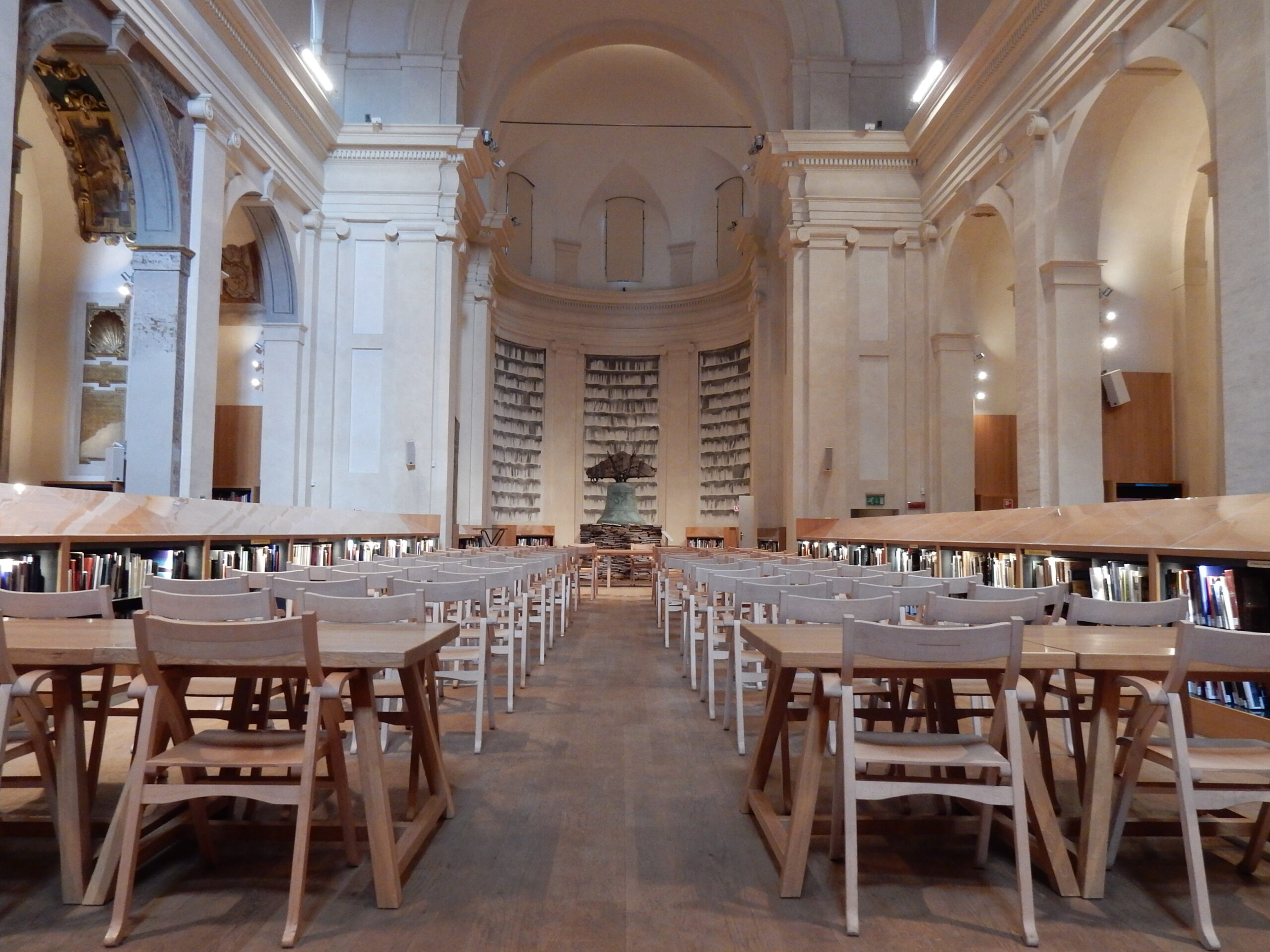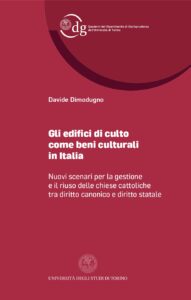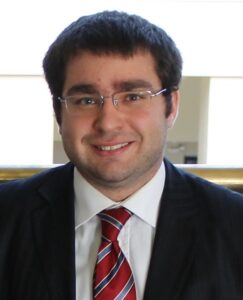
Former San Giorgio in Poggiale Church in Bologna – now art library. Photo: Davide Dimodugno.
The monograph “Buildings of Worship as Cultural Heritage in Italy. New Scenarios for the Management and Reuse of Catholic Churches Between Canon Law and State Law“ intends to deal with a topic of remarkable relevance, which has already emerged in the scholarly debate in Italy, but so far has not been particularly studied in depth in the legal field, namely the management and reuse of places of worship and, more specifically, of Catholic churches, understood as cultural goods of religious interest.
While it is true, in fact, that scholars, predominantly in Law and Religion and in Canon Law, have turned their attention to these issues several times over the past decades, this has mainly occurred through articles in journals or contributions in volumes, never in a systematic way. The present work intends to fill, at least in part, this gap, enhancing the aspects of interdisciplinarity that the topic under scrutiny raises. It stands, in fact, at the intersection of different legal disciplines: canon law, ecclesiastical law, administrative law-especially cultural heritage and urban planning law-constitutional law, European Union law, international law and civil law.
The issue takes on further relevance if we reflect both quantitatively and qualitatively on these assets, which have a historical-artistic value that is quite peculiar in the Italian context. Estimates, in fact, consider that in Italy there are about 95.000 to 100.000 buildings used for Catholic worship, of which at least 85.000 are included in the legal category of “cultural heritage”, such as to represent about 70% of the entire historical-artistic heritage of Italy, together with other properties having an ecclesial character.
With specific reference only to church-owned buildings of worship, the churches census, still in progress, has identified over 67.000. Assuming that reuse could in the future affect as little as 10% of these properties, the above-mentioned numbers plastically render the dimensions of a potentially explosive phenomenon, which could affect thousands of buildings scattered throughout the country, subject to very different legal, conservation and territorial conditions.

Monograph cover, Gli edifici di culto come beni culturali in Italia
The complexity of the topic, which finds its causes in numerous factors, for instance the constant process of secularisation of Western societies – including the Italian one – the decrease in the number of priests, the population shifts from rural and mountainous areas to cities, the emptying of historic centres and the relentless population decline that is affecting our nation, embraces not only many disciplinary scientific fields in law, but also a variety of disciplines, including architecture, theology, sociology, engineering, geography, history, and art history. An attempt has been made, therefore, to refer to the best of scholarship, valuing interdisciplinary reflection and the contribution that important scholars from different scientific backgrounds are giving to the public debate on these issues.
From a methodological point of view, I intended to alternate a theoretical speculation about the problematic profiles that the reduction to profane use and dismissal of churches pose before the scholar and the legal practitioner, with a more practical look, the result of an archival research conducted at the Office of Art and Cultural Heritage of the Archdiocese of Turin, in the North-West of Italy, which allowed a critical examination of 98 concrete examples of reduction to profane use and reuse. The aim was to reconstruct ex post the approach to the problem taken so far by ecclesiastical and civil authorities in a significant number of cases, in order to assess the possibility of improving procedures and practices, through the use of innovative legal solutions, both under public and private law, that go beyond a merely case-by-case vision and allow for a more careful and economically sustainable management of both the buildings that will continue to be used for worship and those that will be used for non-liturgical purposes in the coming years.
In this sense, special attention has been paid to the complex relationship, dare I say of tension, that the phenomenon of church reuse entails between “worship interest” and “cultural interest”, enhancing their tendency to belong to the species of “cultural heritage of religious interest”, as per Article 9 of Legislative Decree No. 42 of January 22, 2004, Code of Cultural Heritage and Landscape. Not for nothing, “cult” and “culture” share the same semantic origin.
The ultimate goal of this research was to identify new solution proposals that, by providing space for the participation not only of the community of the faithful, but of the entire civil society, can allow a sustainable future for this immense heritage of art, culture and religiosity that, in the absence of a significant reversal of the trend, will prove to be overabundant with respect to the religious needs of a population that is now increasingly secularized.
My analysis enlightens the possibility of understanding these assets as common goods. Since they had a social function of public interest protected by the Constitution, i.e., the use for worship, when their purpose ceases, it is necessary to convert the previous bound to a new constraint, for social and cultural activities, compatible with the previous destination. This could be achievable through different legal instruments, such as the collaboration pacts, signed between the owner and groups of citizens, under a framework designed by the municipality; the creation of a participatory foundation, in which all the public and private stakeholders could be involved; the institution of a trust, for a systemic management of ecclesiastical goods in similar ownership conditions in a specific diocese.
I certainly do not have the audacity to “impose” or prospect with absolute certainty what “the” solution to the problem is, therefore I rather prefer to present and propose a broad panorama of possible paths, some marked by a public law management, others by a private law perspective, in any case always keeping clearly in mind the importance of participation and interaction with the communities, in order to achieve more effective and more satisfactory outcomes for all those involved.
The new life given to these assets could allow us to breathe new life into our territories, creating job opportunities, especially for young people, highly qualified in various fields, who could be usefully employed not only in conservation, maintenance, standardisation and restoration works, but also in the elaboration of legal instruments and in the subsequent economically sustainable management of these assets, respecting, however, the original function and the genius loci that continues to pervade buildings of worship, even when they are now used for profane uses.
This type of goods, which as of now we can define as “commons”, is characterised, in fact, by its highly symbolic and evocative form, such as to shape the landscape, and by its spatial centrality, inasmuch as it is capable of standing and imposing itself at the centre of any territorial community, whether it be the neighbourhood of the great metropolis or the small rural or mountain hamlet.
These buildings, often architecturally very valuable, built by our ancestors under the impulse of a great faith and deep religiosity, must return to be useful to the communities that created them, thus making them understand the profound sense of the ecclesia, that is, of a universal community, composed of people rather than stones, open to dialogue and confrontation with everyone.
Only in this way the preservation, enhancement, and enjoyment of these assets, already defined by us as “evocative places of belonging”, can continue to be of twofold interest, both for the community of believers and for civil society.
BIOGRAPHICAL NOTE

Davide Dimodugno is a Postdoctoral research fellow in Canon Law and Law and Religion at the Law Department of the University of Turin (Italy). He received his PhD in “Law and Institutions” with honours in 2022 from the University of Turin, Law Department. He has been a visiting scholar at KU Leuven (Belgium) and Université Paris-Saclay (France). He has published numerous contributions on ecclesial cultural heritage and reuse of buildings of worship and monastic heritage, as well as on religious freedom in pandemics and on “law and religion in opera”. He has participated in dozens of national and international conferences and webinars, including the FRH Biennial Conference “Europe’s Living Religious Heritage” (Bologna Session, “Continuity in Community Connection and Dialogue”, 24 September 2021) and the more recent Canopy Forum and CSLR’s virtual conference on “Religion, Property Law, and the Crisis of Houses of Worship” (3 May 2023) and the 4th International Conference “Architectures of the Soul” (19-21 October 2023). Since 2020 he has been a member of Centro Studi Cherubino Ghirardacci, a study centre in Bologna (Italy) affiliated to FRH.
Since 2023 he has been a member of ICOMOS, International Council for Monuments and Sites, FRH, Future for Religious Heritage, ESACH, European Students’ Association for Cultural Heritage, ICLARS, International Consortium for Law and Religion Studies, and an aggregate member of ADEC, Association of Academics in Law and Religion in Italy. He is licensed to practice law.
See personal profile, with contact details and research products





Follow us: